How to implement the springboot picture verification code function module
The specific effect is as follows:
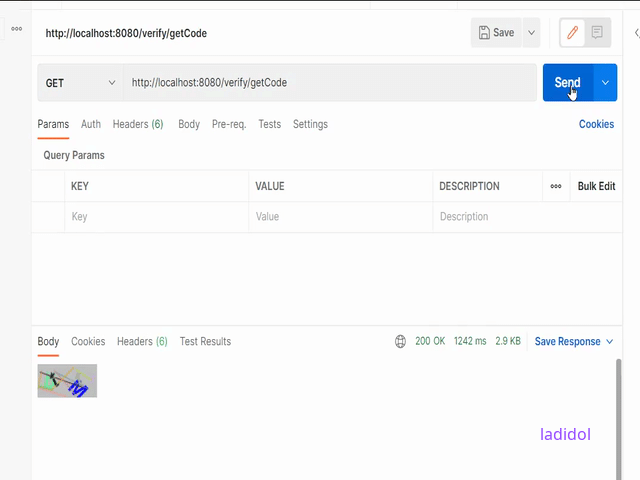
Step one: Tool class
This tool class is the core of generating verification code images ,You can copy it directly to the project without modification; all the parameters that can be personalized are provided by the API, such as font size, background color,The number of interference lines, height and width, etc. can be set according to your own needs;
Almost every line of the code has detailed comments; if you encounter a special personality Customization needs can be achieved by adjusting this tool class.
package com.feng.util;
/**
* @return null
* @author Ladidol
* @description
* @date 2022/4/11 22:15
*/
import java.awt.*;
import java.awt.geom.AffineTransform;
import java.awt.image.BufferedImage;
import java.util.Random;
/**
* 图形验证码生成
*/
public class VerifyUtil {
// 默认验证码字符集
private static final char[] chars = {
'0', '1', '2', '3', '4', '5', '6', '7', '8', '9',
'a', 'b', 'c', 'd', 'e', 'f', 'g', 'h', 'i', 'j', 'k', 'l', 'm', 'n', 'o', 'p', 'q', 'r', 's', 't', 'u', 'v', 'w', 'x', 'y', 'z',
'A', 'B', 'C', 'D', 'E', 'F', 'G', 'H', 'I', 'J', 'K', 'L', 'M', 'N', 'O', 'P', 'Q', 'R', 'S', 'T', 'U', 'V', 'W', 'X', 'Y', 'Z'};
// 默认字符数量
private final Integer SIZE;
// 默认干扰线数量
private final int LINES;
// 默认宽度
private final int WIDTH;
// 默认高度
private final int HEIGHT;
// 默认字体大小
private final int FONT_SIZE;
// 默认字体倾斜
private final boolean TILT;
private final Color BACKGROUND_COLOR;
/**
* 初始化基础参数
*
* @param builder
*/
private VerifyUtil(Builder builder) {
SIZE = builder.size;
LINES = builder.lines;
WIDTH = builder.width;
HEIGHT = builder.height;
FONT_SIZE = builder.fontSize;
TILT = builder.tilt;
BACKGROUND_COLOR = builder.backgroundColor;
}
/**
* 实例化构造器对象
*
* @return
*/
public static Builder newBuilder() {
return new Builder();
}
/**
* @return 生成随机验证码及图片
* Object[0]:验证码字符串;
* Object[1]:验证码图片。
*/
public Object[] createImage() {
StringBuffer sb = new StringBuffer();
// 创建空白图片
BufferedImage image = new BufferedImage(WIDTH, HEIGHT, BufferedImage.TYPE_INT_RGB);
// 获取图片画笔
Graphics2D graphic = image.createGraphics();
// 设置抗锯齿
graphic.setRenderingHint(RenderingHints.KEY_ANTIALIASING, RenderingHints.VALUE_ANTIALIAS_ON);
// 设置画笔颜色
graphic.setColor(BACKGROUND_COLOR);
// 绘制矩形背景
graphic.fillRect(0, 0, WIDTH, HEIGHT);
// 画随机字符
Random ran = new Random();
//graphic.setBackground(Color.WHITE);
// 计算每个字符占的宽度,这里预留一个字符的位置用于左右边距
int codeWidth = WIDTH / (SIZE + 1);
// 字符所处的y轴的坐标
int y = HEIGHT * 3 / 4;
for (int i = 0; i < SIZE; i++) {
// 设置随机颜色
graphic.setColor(getRandomColor());
// 初始化字体
Font font = new Font(null, Font.BOLD + Font.ITALIC, FONT_SIZE);
if (TILT) {
// 随机一个倾斜的角度 -45到45度之间
int theta = ran.nextInt(45);
// 随机一个倾斜方向 左或者右
theta = (ran.nextBoolean() == true) ? theta : -theta;
AffineTransform affineTransform = new AffineTransform();
affineTransform.rotate(Math.toRadians(theta), 0, 0);
font = font.deriveFont(affineTransform);
}
// 设置字体大小
graphic.setFont(font);
// 计算当前字符绘制的X轴坐标
int x = (i * codeWidth) + (codeWidth / 2);
// 取随机字符索引
int n = ran.nextInt(chars.length);
// 得到字符文本
String code = String.valueOf(chars[n]);
// 画字符
graphic.drawString(code, x, y);
// 记录字符
sb.append(code);
}
// 画干扰线
for (int i = 0; i < LINES; i++) {
// 设置随机颜色
graphic.setColor(getRandomColor());
// 随机画线
graphic.drawLine(ran.nextInt(WIDTH), ran.nextInt(HEIGHT), ran.nextInt(WIDTH), ran.nextInt(HEIGHT));
}
// 返回验证码和图片
return new Object[]{sb.toString(), image};
}
/**
* 随机取色
*/
private Color getRandomColor() {
Random ran = new Random();
Color color = new Color(ran.nextInt(256), ran.nextInt(256), ran.nextInt(256));
return color;
}
/**
* 构造器对象
*/
public static class Builder {
// 默认字符数量
private int size = 4;
// 默认干扰线数量
private int lines = 10;
// 默认宽度
private int width = 80;
// 默认高度
private int height = 35;
// 默认字体大小
private int fontSize = 25;
// 默认字体倾斜
private boolean tilt = true;
//背景颜色
private Color backgroundColor = Color.LIGHT_GRAY;
public Builder setSize(int size) {
this.size = size;
return this;
}
public Builder setLines(int lines) {
this.lines = lines;
return this;
}
public Builder setWidth(int width) {
this.width = width;
return this;
}
public Builder setHeight(int height) {
this.height = height;
return this;
}
public Builder setFontSize(int fontSize) {
this.fontSize = fontSize;
return this;
}
public Builder setTilt(boolean tilt) {
this.tilt = tilt;
return this;
}
public Builder setBackgroundColor(Color backgroundColor) {
this.backgroundColor = backgroundColor;
return this;
}
public VerifyUtil build() {
return new VerifyUtil(this);
}
}
}Step 2: Image generation:
Use default parameters:
//生成图片验证码 Object[] verify = VerifyUtil.newBuilder().build().createImage();
Custom parameter generation:
// 这个根据自己的需要设置对应的参数来实现个性化
// 返回的数组第一个参数是生成的验证码,第二个参数是生成的图片
Object[] objs = VerifyUtil.newBuilder()
.setWidth(120) //设置图片的宽度
.setHeight(35) //设置图片的高度
.setSize(6) //设置字符的个数
.setLines(10) //设置干扰线的条数
.setFontSize(25) //设置字体的大小
.setTilt(true) //设置是否需要倾斜
.setBackgroundColor(Color.WHITE) //设置验证码的背景颜色
.build() //构建VerifyUtil项目
.createImage(); //生成图片Integrate into springboot project:
Maven dependencies that need to be introduced:
<!--redis相关配置-->
<dependency>
<groupId>org.springframework.boot</groupId>
<artifactId>spring-boot-starter-data-redis</artifactId>
</dependency>
<!-- redis 连接池 -->
<!--新版本连接池lettuce-->
<dependency>
<groupId>org.apache.commons</groupId>
<artifactId>commons-pool2</artifactId>
</dependency>
<!-- 图形验证码 -->
<dependency>
<groupId>net.jodah</groupId>
<artifactId>expiringmap</artifactId>
<version>0.5.10</version>
</dependency>Get the relevant verification code:
service layer:
package com.feng.service;
import org.cuit.epoch.result.Result;
import javax.servlet.http.HttpServletRequest;
import javax.servlet.http.HttpServletResponse;
import java.io.IOException;
/**
* @return null
* @author Ladidol
* @description
* @date 2022/4/11 22:15
*/
public interface VerifyService {
/**
* 创建图片验证码
* @param response
* @param request
* @throws IOException
*/
void createCode(HttpServletResponse response, HttpServletRequest request) throws IOException;
/**
* 检查图片验证码
* @param
* @param
* @throws IOException
*/
Result<String> checkCode(String verificationCode);
}serviceimpl Layer:
package com.feng.service.impl;
import com.feng.service.VerifyService;
import com.feng.util.RedisServiceImpl;
import com.google.common.net.HttpHeaders;
import com.feng.util.VerifyUtil;
import org.springframework.http.ResponseCookie;
import org.springframework.stereotype.Service;
import javax.annotation.Resource;
import javax.imageio.ImageIO;
import javax.servlet.http.HttpServletRequest;
import javax.servlet.http.HttpServletResponse;
import javax.servlet.http.HttpSession;
import java.awt.image.BufferedImage;
import java.io.IOException;
import java.io.OutputStream;
import java.time.Duration;
/**
* @return null
* @author Ladidol
* @description
* @date 2022/4/11 22:15
*/
@Service
public class VerifyServiceImpl implements VerifyService {
@Resource
RedisServiceImpl redisUtil;
/**
* 生成图片验证码
* @param response
* @param request
* @throws IOException
*/
@Override
public void createCode(HttpServletResponse response, HttpServletRequest request) throws IOException {
//获取session
HttpSession session = request.getSession();
//获得sessionId
String id = session.getId();
System.out.println();
ResponseCookie cookie = ResponseCookie.from("JSESSIONID",id)
.secure(true)
.domain("")
.path("/")
.maxAge(Duration.ofHours(1))
.sameSite("None")
.build();
//清除之前缓存的图片验证码
if (!String.valueOf(request.getSession().getAttribute("SESSION_VERIFY_CODE_"+id)).isEmpty()){
String getVerify = String.valueOf(request.getSession().getAttribute("SESSION_VERIFY_CODE_"+id));
redisUtil.del(getVerify);
System.out.println("清除成功");
}
//生成图片验证码,用的默认参数
Object[] verify = VerifyUtil.newBuilder().build().createImage();
//将验证码存入session
session.setAttribute("SESSION_VERIFY_CODE_" + id, verify[0]);
//打印验证码
System.out.println(verify[0]);
//将验证码存入redis
redisUtil.set((String) verify[0],id,5*60);
//将图片传给浏览器
BufferedImage image = (BufferedImage) verify[1];
response.setContentType("image/png");
response.setHeader(HttpHeaders.SET_COOKIE,cookie.toString());
OutputStream ops = response.getOutputStream();
ImageIO.write(image,"png",ops);
}
@Override
public Result<String> checkCode(String verificationCode){
if (!redisUtil.hasKey(verificationCode)){
return new Result<>(false,"验证码错误");
}
redisUtil.del(verificationCode);
return R.success();
}
}There are also redis-related tool classes used here, so I won’t list them. If you want, you can check out my previous blog tool classes here
Controller layer:
@RequiredArgsConstructor is useful here, it is just a simple injection. If you want to know more about it, click here
package com.feng.controller;
import lombok.RequiredArgsConstructor;
import com.feng.annotation.LimitRequest;
import com.feng.service.VerifyService;
import org.springframework.web.bind.annotation.*;
import javax.servlet.http.HttpServletRequest;
import javax.servlet.http.HttpServletResponse;
import java.io.IOException;
/**
* @return null
* @author Ladidol
* @description 这里主要就是多种验证码和登录相关的东西
* @date 2022/4/11 21:46
*/
@RestController
@RequestMapping("/verify")
@RequiredArgsConstructor//这是在lombok工具给的注入方式,真帅
public class VerifyController {
private final VerifyService verifyService;
/**
* 获取图片验证码
*/
@LimitRequest(count = 5)//这个注解就是表示, 你在限制时间里(我们这里默认是六秒钟), 只能请求五次
@GetMapping("/getCode")
public void getCode(HttpServletResponse response, HttpServletRequest request) throws IOException {
verifyService.createCode(response, request);
}
@LimitRequest(count = 5)//这个注解就是表示, 你在限制时间里(我们这里默认是六秒钟), 只能请求五次
@GetMapping("/checkCode")
public Result<String> checkCode(String code){
return verifyService.checkCode(code);
}
}In order not to have unrestricted access to the service, We used an annotation @LimitRequest
annotation class under the annotation package:
package com.feng.annotation;
import java.lang.annotation.*;
/**
* @return null
* @author Ladidol
* @description 限制ip访问次数注解
* @date 2022/4/11 22:15
*/
@Documented
@Target(ElementType.METHOD) // 说明该注解只能放在方法上面
@Retention(RetentionPolicy.RUNTIME)
public @interface LimitRequest {
long time() default 6000; // 限制时间 单位:毫秒
int count() default 3; // 允许请求的次数
}under the aspect package Aspect class:
package com.feng.aspect;
import net.jodah.expiringmap.ExpirationPolicy;
import net.jodah.expiringmap.ExpiringMap;
import org.aspectj.lang.ProceedingJoinPoint;
import org.aspectj.lang.annotation.Around;
import org.aspectj.lang.annotation.Aspect;
import org.aspectj.lang.annotation.Pointcut;
import com.feng.annotation.LimitRequest;
import org.cuit.epoch.exception.AppException;
import org.springframework.stereotype.Component;
import org.springframework.web.context.request.RequestAttributes;
import org.springframework.web.context.request.RequestContextHolder;
import org.springframework.web.context.request.ServletRequestAttributes;
import javax.servlet.http.HttpServletRequest;
import java.util.concurrent.ConcurrentHashMap;
import java.util.concurrent.TimeUnit;
/**
* @return null
* @author Ladidol
* @description
* @date 2022/4/11 22:15
*/
@Aspect
@Component
public class LimitRequestAspect {
private static ConcurrentHashMap<String, ExpiringMap<String, Integer>> book = new ConcurrentHashMap<>();
// 定义切点
// 让所有有@LimitRequest注解的方法都执行切面方法
@Pointcut("@annotation(limitRequest)")
public void excudeService(LimitRequest limitRequest) {
}
@Around("excudeService(limitRequest)")
public Object doAround(ProceedingJoinPoint pjp, LimitRequest limitRequest) throws Throwable {
// 获得request对象
RequestAttributes ra = RequestContextHolder.getRequestAttributes();
ServletRequestAttributes sra = (ServletRequestAttributes) ra;
HttpServletRequest request = sra.getRequest();
// 获取Map对象, 如果没有则返回默认值
// 第一个参数是key, 第二个参数是默认值
ExpiringMap<String, Integer> uc = book.getOrDefault(request.getRequestURI(), ExpiringMap.builder().variableExpiration().build());
Integer uCount = uc.getOrDefault(request.getRemoteAddr(), 0);
if (uCount >= limitRequest.count()) { // 超过次数,不执行目标方法
System.out.println("接口请求超过次数!");
throw new AppException("接口请求超过次数!");
} else if (uCount == 0) { // 第一次请求时,设置有效时间
//
uc.put(request.getRemoteAddr(), uCount + 1, ExpirationPolicy.CREATED, limitRequest.time(), TimeUnit.MILLISECONDS);
} else { // 未超过次数, 记录加一
uc.put(request.getRemoteAddr(), uCount + 1);
}
book.put(request.getRequestURI(), uc);
// result的值就是被拦截方法的返回值
Object result = pjp.proceed();
return result;
}
}In order to capture the global exception thrown and comply with restful specifications, we add this processing class:
The global exception class under the handle package:
package org.cuit.epoch.handler;
import lombok.extern.log4j.Log4j2;
import org.cuit.epoch.exception.AppException;
import org.cuit.epoch.result.R;
import org.cuit.epoch.result.Result;
import org.springframework.web.bind.annotation.ControllerAdvice;
import org.springframework.web.bind.annotation.ExceptionHandler;
import org.springframework.web.bind.annotation.ResponseBody;
@ControllerAdvice
@Log4j2
public class GlobalExceptionHandler {
@ExceptionHandler(Exception.class)
@ResponseBody
public Result error(Exception e) {
log.error(e.getMessage());
e.printStackTrace();
return R.fail(e.getMessage());
}
@ExceptionHandler(AppException.class)
@ResponseBody
public Result error(AppException e) {
log.error(e.getMessage());
e.printStackTrace();
return R.fail(e.getMessage());
}
}application.yaml file:
spring:
cache:
type:
redis
redis: #redis连接配置
host: 自己redis的ip地址
port: redis端口
password: 密码
jedis:
pool:
max-active: 8
max-wait: -1ms
max-idle: 500
min-idle: 0
lettuce:
shutdown-timeout: 0msThe final project structure is as follows:
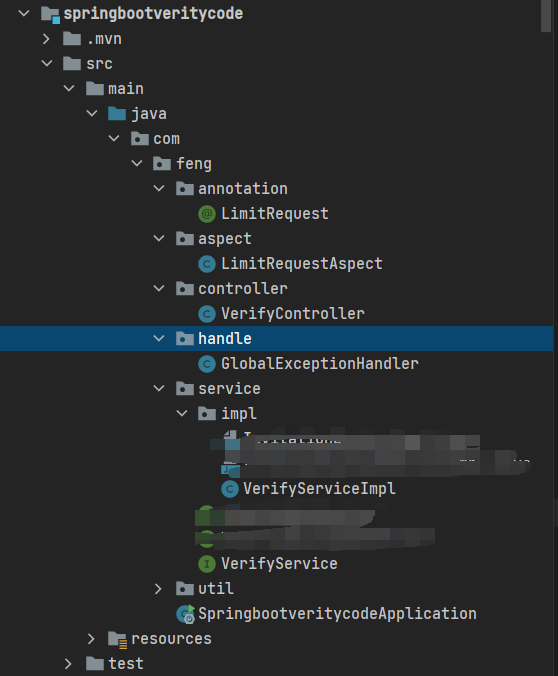
Get a verification code first:
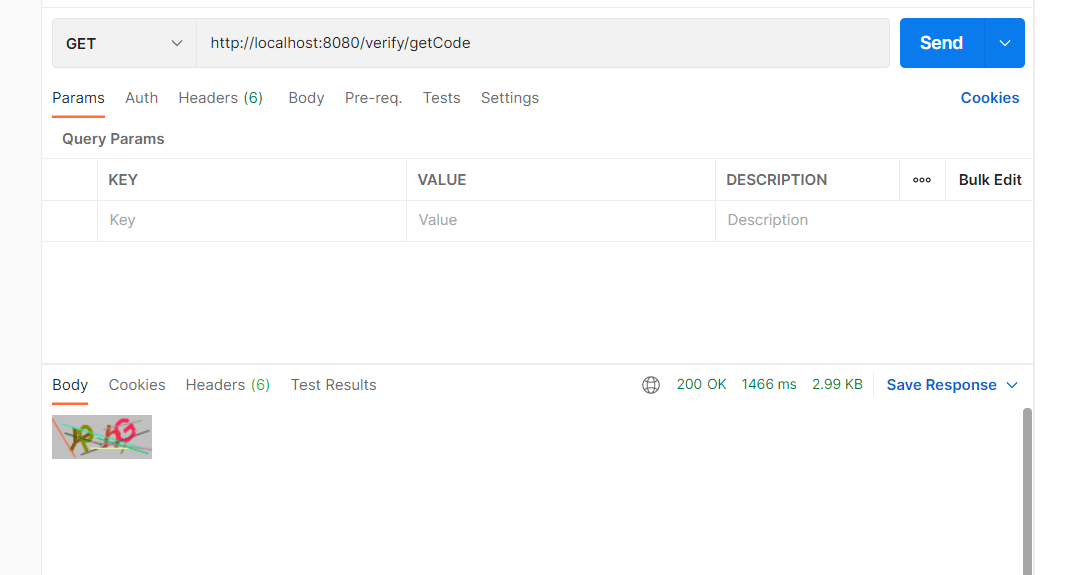
Verify whether it is successful:
Successful result:
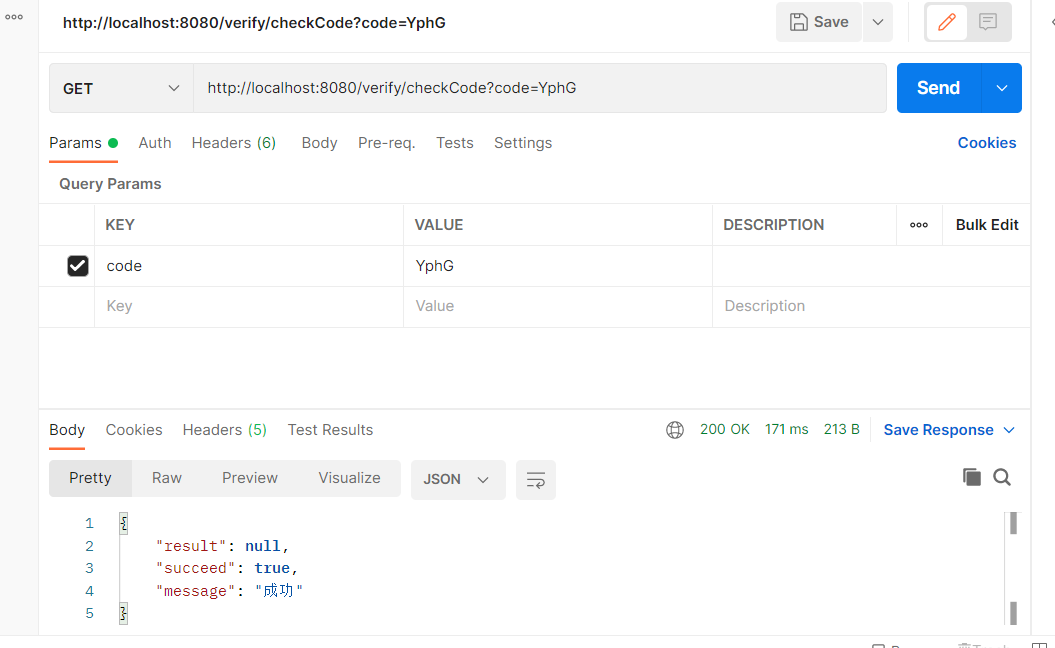
Verification failure result:
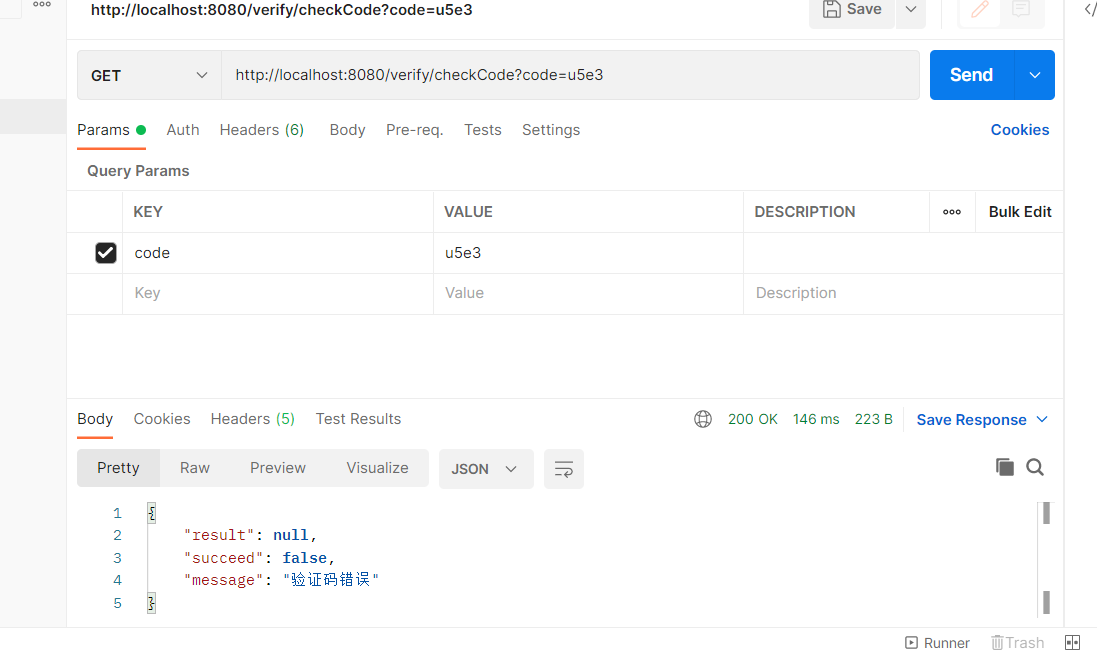
When the number of requests within the specified time exceeds the specified number or There is an error:
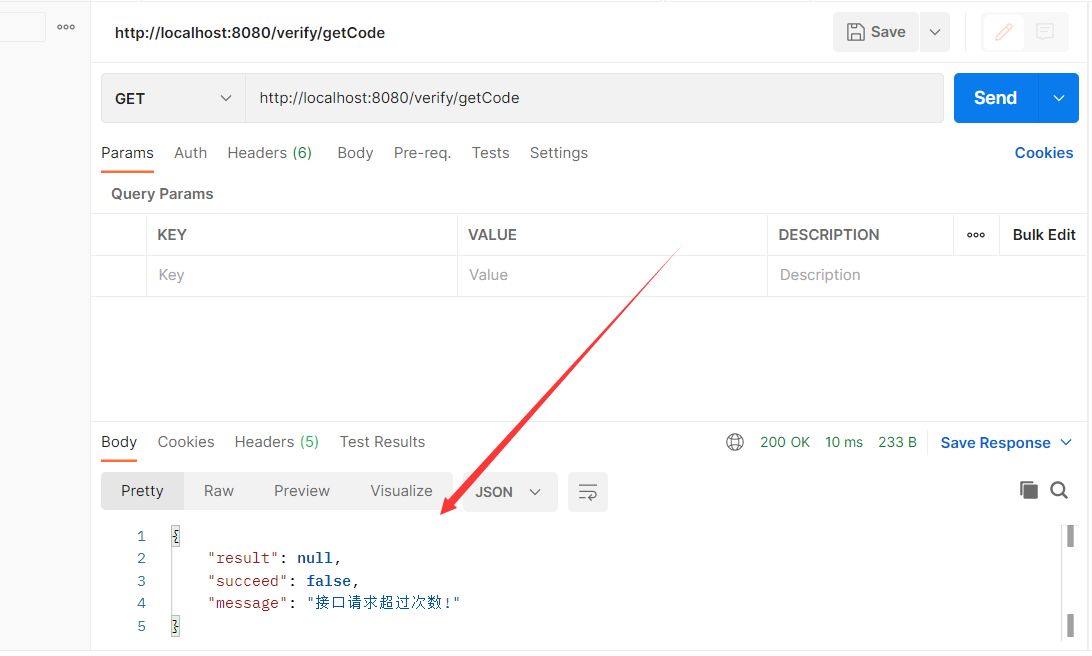
The above is the detailed content of How to implement the springboot picture verification code function module. For more information, please follow other related articles on the PHP Chinese website!

Hot AI Tools

Undresser.AI Undress
AI-powered app for creating realistic nude photos

AI Clothes Remover
Online AI tool for removing clothes from photos.

Undress AI Tool
Undress images for free

Clothoff.io
AI clothes remover

AI Hentai Generator
Generate AI Hentai for free.

Hot Article

Hot Tools

Notepad++7.3.1
Easy-to-use and free code editor

SublimeText3 Chinese version
Chinese version, very easy to use

Zend Studio 13.0.1
Powerful PHP integrated development environment

Dreamweaver CS6
Visual web development tools

SublimeText3 Mac version
God-level code editing software (SublimeText3)

Hot Topics
 1378
1378
 52
52
 How Springboot integrates Jasypt to implement configuration file encryption
Jun 01, 2023 am 08:55 AM
How Springboot integrates Jasypt to implement configuration file encryption
Jun 01, 2023 am 08:55 AM
Introduction to Jasypt Jasypt is a java library that allows a developer to add basic encryption functionality to his/her project with minimal effort and does not require a deep understanding of how encryption works. High security for one-way and two-way encryption. , standards-based encryption technology. Encrypt passwords, text, numbers, binaries... Suitable for integration into Spring-based applications, open API, for use with any JCE provider... Add the following dependency: com.github.ulisesbocchiojasypt-spring-boot-starter2. 1.1Jasypt benefits protect our system security. Even if the code is leaked, the data source can be guaranteed.
 How SpringBoot integrates Redisson to implement delay queue
May 30, 2023 pm 02:40 PM
How SpringBoot integrates Redisson to implement delay queue
May 30, 2023 pm 02:40 PM
Usage scenario 1. The order was placed successfully but the payment was not made within 30 minutes. The payment timed out and the order was automatically canceled. 2. The order was signed and no evaluation was conducted for 7 days after signing. If the order times out and is not evaluated, the system defaults to a positive rating. 3. The order is placed successfully. If the merchant does not receive the order for 5 minutes, the order is cancelled. 4. The delivery times out, and push SMS reminder... For scenarios with long delays and low real-time performance, we can Use task scheduling to perform regular polling processing. For example: xxl-job Today we will pick
 How to use Redis to implement distributed locks in SpringBoot
Jun 03, 2023 am 08:16 AM
How to use Redis to implement distributed locks in SpringBoot
Jun 03, 2023 am 08:16 AM
1. Redis implements distributed lock principle and why distributed locks are needed. Before talking about distributed locks, it is necessary to explain why distributed locks are needed. The opposite of distributed locks is stand-alone locks. When we write multi-threaded programs, we avoid data problems caused by operating a shared variable at the same time. We usually use a lock to mutually exclude the shared variables to ensure the correctness of the shared variables. Its scope of use is in the same process. If there are multiple processes that need to operate a shared resource at the same time, how can they be mutually exclusive? Today's business applications are usually microservice architecture, which also means that one application will deploy multiple processes. If multiple processes need to modify the same row of records in MySQL, in order to avoid dirty data caused by out-of-order operations, distribution needs to be introduced at this time. The style is locked. Want to achieve points
 How to solve the problem that springboot cannot access the file after reading it into a jar package
Jun 03, 2023 pm 04:38 PM
How to solve the problem that springboot cannot access the file after reading it into a jar package
Jun 03, 2023 pm 04:38 PM
Springboot reads the file, but cannot access the latest development after packaging it into a jar package. There is a situation where springboot cannot read the file after packaging it into a jar package. The reason is that after packaging, the virtual path of the file is invalid and can only be accessed through the stream. Read. The file is under resources publicvoidtest(){Listnames=newArrayList();InputStreamReaderread=null;try{ClassPathResourceresource=newClassPathResource("name.txt");Input
 How to implement Springboot+Mybatis-plus without using SQL statements to add multiple tables
Jun 02, 2023 am 11:07 AM
How to implement Springboot+Mybatis-plus without using SQL statements to add multiple tables
Jun 02, 2023 am 11:07 AM
When Springboot+Mybatis-plus does not use SQL statements to perform multi-table adding operations, the problems I encountered are decomposed by simulating thinking in the test environment: Create a BrandDTO object with parameters to simulate passing parameters to the background. We all know that it is extremely difficult to perform multi-table operations in Mybatis-plus. If you do not use tools such as Mybatis-plus-join, you can only configure the corresponding Mapper.xml file and configure The smelly and long ResultMap, and then write the corresponding sql statement. Although this method seems cumbersome, it is highly flexible and allows us to
 Comparison and difference analysis between SpringBoot and SpringMVC
Dec 29, 2023 am 11:02 AM
Comparison and difference analysis between SpringBoot and SpringMVC
Dec 29, 2023 am 11:02 AM
SpringBoot and SpringMVC are both commonly used frameworks in Java development, but there are some obvious differences between them. This article will explore the features and uses of these two frameworks and compare their differences. First, let's learn about SpringBoot. SpringBoot was developed by the Pivotal team to simplify the creation and deployment of applications based on the Spring framework. It provides a fast, lightweight way to build stand-alone, executable
 How SpringBoot customizes Redis to implement cache serialization
Jun 03, 2023 am 11:32 AM
How SpringBoot customizes Redis to implement cache serialization
Jun 03, 2023 am 11:32 AM
1. Customize RedisTemplate1.1, RedisAPI default serialization mechanism. The API-based Redis cache implementation uses the RedisTemplate template for data caching operations. Here, open the RedisTemplate class and view the source code information of the class. publicclassRedisTemplateextendsRedisAccessorimplementsRedisOperations, BeanClassLoaderAware{//Declare key, Various serialization methods of value, the initial value is empty @NullableprivateRedisSe
 How to get the value in application.yml in springboot
Jun 03, 2023 pm 06:43 PM
How to get the value in application.yml in springboot
Jun 03, 2023 pm 06:43 PM
In projects, some configuration information is often needed. This information may have different configurations in the test environment and the production environment, and may need to be modified later based on actual business conditions. We cannot hard-code these configurations in the code. It is best to write them in the configuration file. For example, you can write this information in the application.yml file. So, how to get or use this address in the code? There are 2 methods. Method 1: We can get the value corresponding to the key in the configuration file (application.yml) through the ${key} annotated with @Value. This method is suitable for situations where there are relatively few microservices. Method 2: In actual projects, When business is complicated, logic




